What Is Typically in Beef With Garlic Sauce at a Chinese Resturant
You may have ordered Hunan Beef from your local takeout joint before.
The Americanized version is pretty variable, depending on who's making it. I once asked my father and other Chinese restaurant chefs—what's the bargain with Hunan Beef? Even they confessed to not know much nigh it other than the way that particular restaurant prepared it!
Americanized Hunan Beef vs. Authentic Hunan Beef
Let'southward set the record straight. There'southward an Americanized way to gear up Hunan Beef, and an accurate Chinese way.
This is—you guessed it—an authentic Chinese Hunan Beef recipe, so you all can taste what Hunan Beef should really be like!
In my opinion, the Chinese American version is also often the same every bit any other chocolate-brown sauce stir-fry (similar beef with mixed vegetables, beef with string beans, etc.), and but not equally tasty as what you tin find in China.
Most Chinese takeout restaurants only add peppers, a few dried chili peppers, and chili oil to a basic Chinese stir-fry sauce . While Hunan Province is known for its beloved of spicy peppers, though, calculation a few peppers to the dish does not brand information technology accurate Hunan!
Hunan Beef in China is unremarkably smoky and spicy. Dry smoked beefiness is a specialty of the region. Near like beef jerky, this beef is reinvigorated when it hits a wok full of peppers and fermented black beans.
Information technology'southward a hard-to-find ingredient (a local and incredibly accurate Hunan restaurant in our expanse makes their ain!), and then we're using regular beefiness and lightly frying it to create that dry, crispy texture.
Trust us. If you give this dish a try, you'll have a real gustation of China right in your kitchen!

What'due south the Departure Betwixt Hunan and Sichuan (Szechuan) Cooking?
While Hunan and Sichuan cooking both make liberal use of chili peppers, there are some cardinal differences. Many of you are familiar with Sichuan cooking (information technology's grown in popularity exterior of China in recent years), but you lot might be scratching your heads about what exactly Hunan cooking is similar.
The key difference is that alongside chili peppers, Sichuan cooking often uses the flavour of numbing Sichuan peppercorns (in a dish of spicy numbing Mapo Tofu, for instance). In Hunan cooking, spicy peppers are used without a numbing agent, creating a " gan la " (干辣) or "dry spicy" flavor rather than " ma la" (麻辣) or spicy numbing season.
Hunan dishes are more purely spicy, with dried, fresh, and/or pickled peppers used to add depth and variation, forth with lots of garlic, fresh ginger, fermented black beans, other pickled ingredients (like pickled long beans ), and cured/smoked ingredients. Most accurate Hunan stir fry dishes also do not have much sauce, making them drier than many Sichuan dishes, which employ more oil.
Every bit a effect, it's well known among Chinese people that Hunan dishes tin can really exist spicier than those from Sichuan! (Those of you who've sweated over Sichuan nutrient are probably in atheism right now.)
To try more Hunan dishes in improver to this i, here are some of our other Hunan recipes:
- Hunan Pork and Tofu
- Hunan-Way Whole Steamed Fish
- Hunan-Style Eggplant
- Pickled Long Beans with Pork
- Eggplant Cord Bean Stir-fry
- Steamed Duo Jiao Fish
Picking Your Peppers
Always since we started the blog, the pepper-loving community has really kept us on our toes about pepper varieties and spice levels!
Peppers are vital to Hunan Beef, but the peppers yous use are a matter of personal preference. We similar to use a variety—both spicy and sweetness. Poblano and The netherlands peppers are mild, merely if you want more than spice, you can add Fresnos or jalapeños to the mix. We had a corking pepper crop in our garden this year, so we used a mix of what nosotros had!
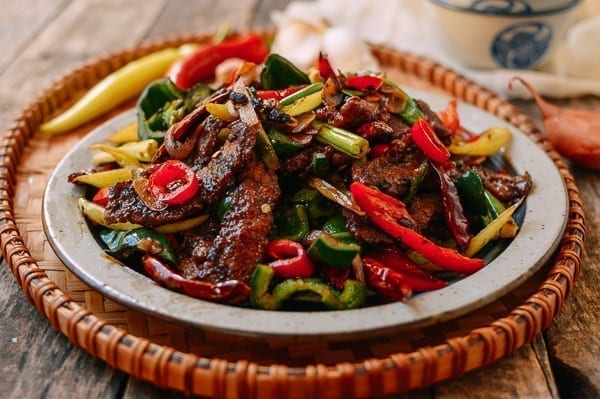
Remember that the addition of the dried chili peppers can add a lot of spice (also depending on whether you chop them to release the seeds within or leave them whole), so you'll want to consider those factors as well.
Hunan Beefiness Recipe Instructions
Pace ane: Marinate the Beef
In a medium bowl, combine the sliced flank steak with the baking soda, water and oyster sauce . Massage these ingredients into the beef until whatsoever liquid has been absorbed by the meat. Marinate for thirty minutes. For more information on preparing beef, see Pecker's post on How to Piece and Velvet Beef for stir fries.
Side by side, lightly dredge all of the beefiness slices in cornstarch. Set aside until ready to fry.
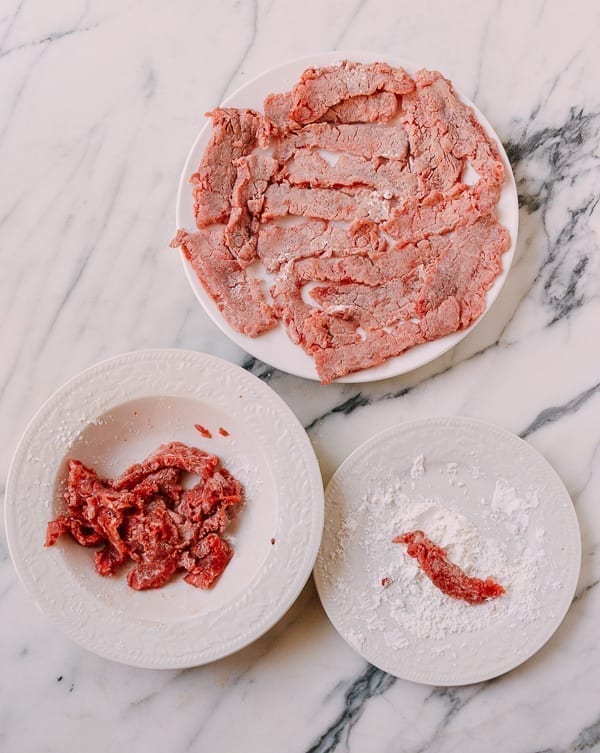
This technique is similar to what we do in our Mongolian Beef to create a crispy chaff, only for more details on marinating beef, run into our postal service on How to Prepare Beef for Stir Fry.
Step 2: Prepare Peppers
Slice all the fresh peppers crosswise into thin slices on the diagonal. Fix aside the dried red peppers. Do not break them open or chop unless you want a very spicy Hunan Beef!
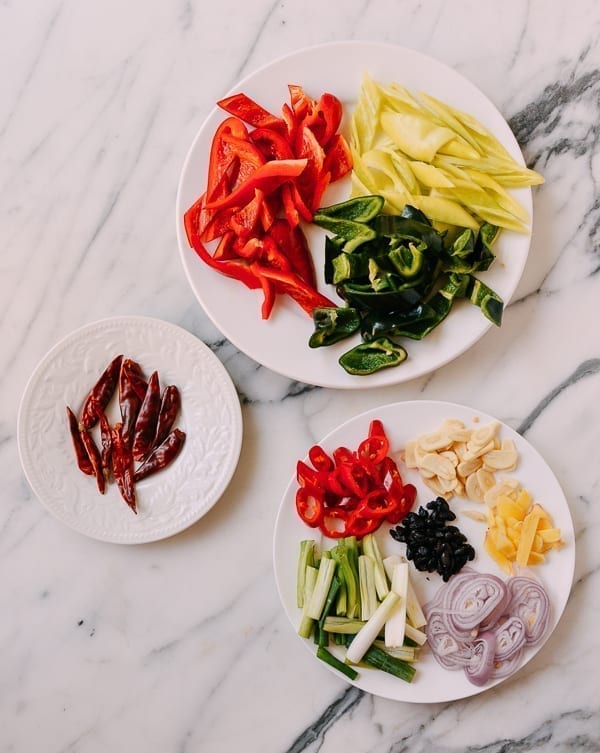
At this time, you may likewise want to prepare the other ingredients––the shallots, ginger, garlic, black beans, and scallions.
Step 3: Prepare Sauce
Stir the sugar into 2 tablespoons of hot water until dissolved. Add the Chinese black vinegar, soy sauce, and ground white pepper. Mix until well combined and prepare bated.
Pace four: Fry the Beef
Oestrus your wok over high heat until smoking. Spread ⅓ loving cup oil around the wok, and sear the beef in three batches on both sides until browned and slightly crispy on the outside.
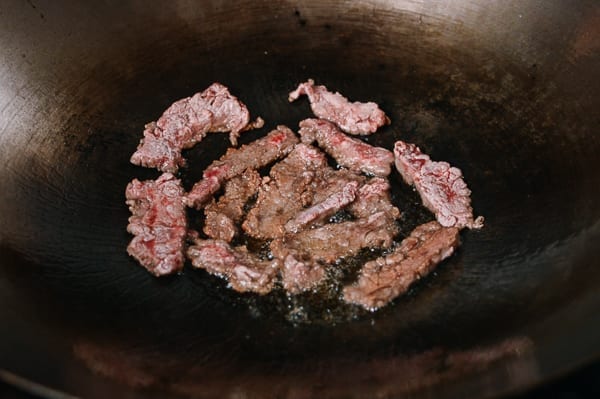
Be certain the wok and oil are hot each time you add a batch of beef.
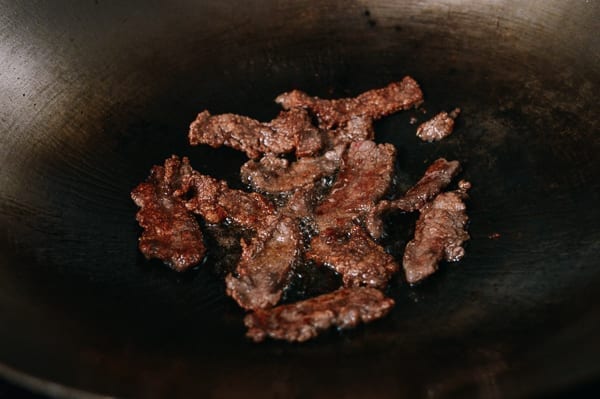
Drain the crispy beefiness past moving it upward to the side of the wok.
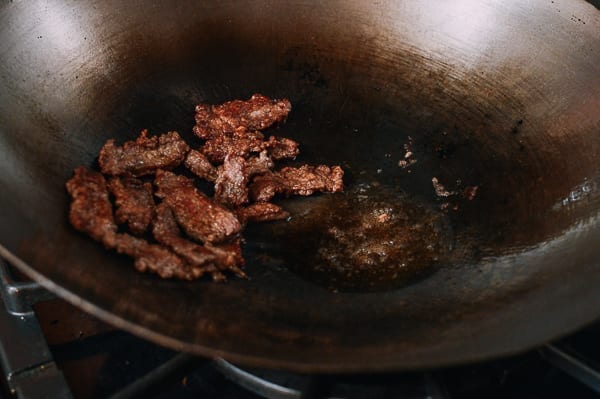
The oil will drain to the lesser and you tin can then transfer the beef to a sheet pan or plate. No need for newspaper towels or wire racks!
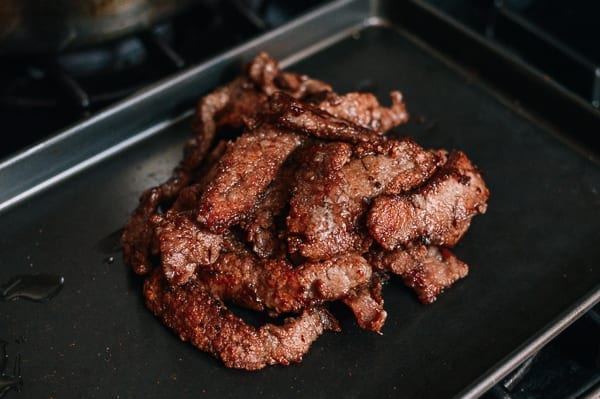
After frying the beef, leave about two tablespoons of the oil in the wok, and remove whatsoever excess. If your wok got burned in the frying process, this is a proficient time to launder it. While you want the beef flavour from frying, yous definitely don't want burned bits in the stir-fry if you got carried away with the heat during frying.
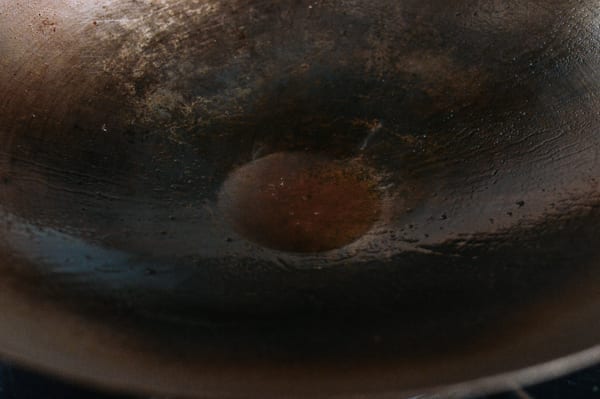
Footstep 5: Assemble the Hunan Beef
Set the wok over medium heat. Add the sliced ginger and fry until caramelized, about 30 seconds.
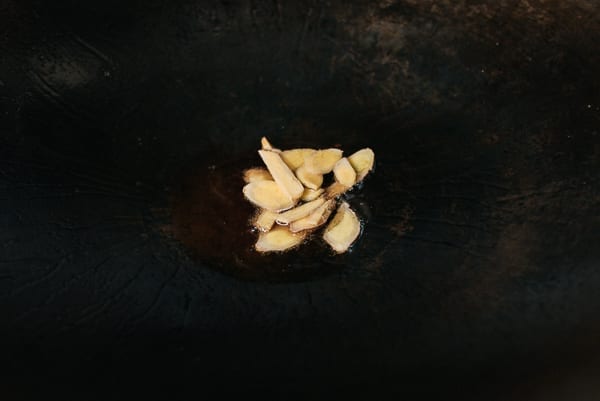
Next, add together the shallots.
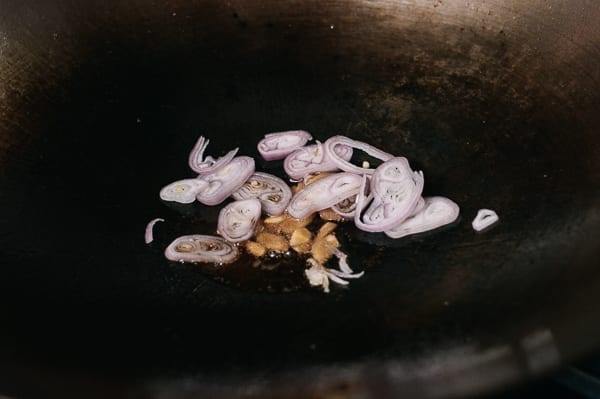
Keep to fry for another 30 seconds, and add the fresh peppers (except for the red holland or fresno peppers). Turn the heat upward to high and stir-fry for 1 minute to get a prissy sear on the peppers.
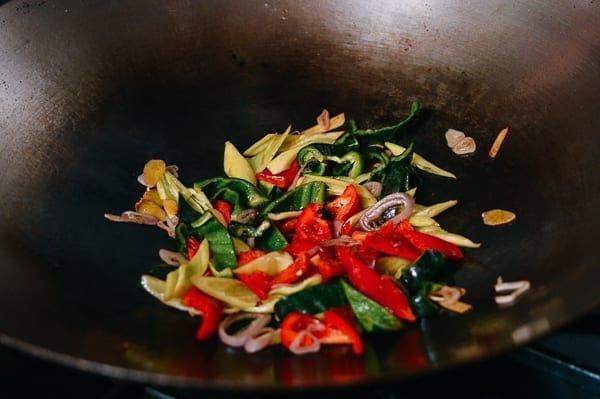
Articulate a section on the bottom of the wok, and add the dried chili peppers. Let them toast in the oil for 20 seconds. (If you want your dish spicier, add the dried chili peppers earlier, forth with the shallots.)
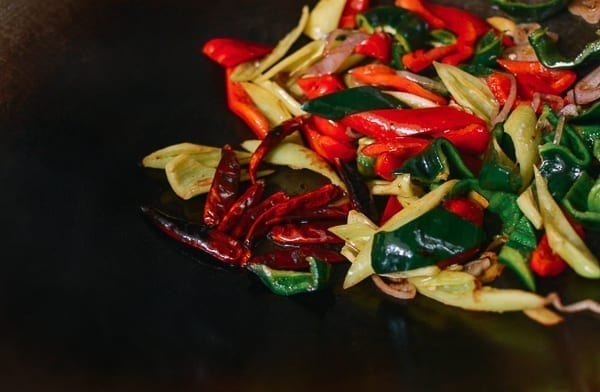
Side by side, pour the Shaoxing wine around the perimeter of the wok. Add together the sliced garlic , fermented black beans, and the red Holland or Fresno peppers. Stir-fry for another 30 to sixty seconds on high heat.
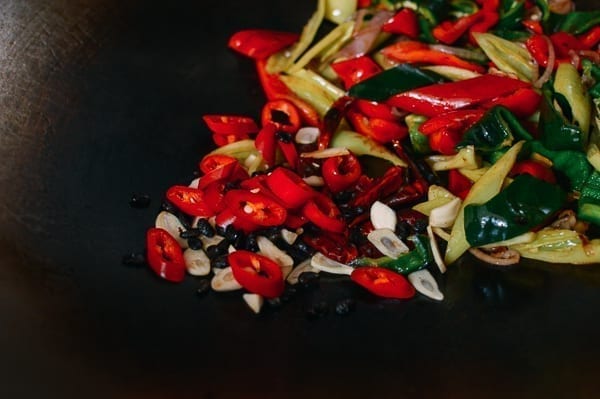
Adjacent, add the fried beef…
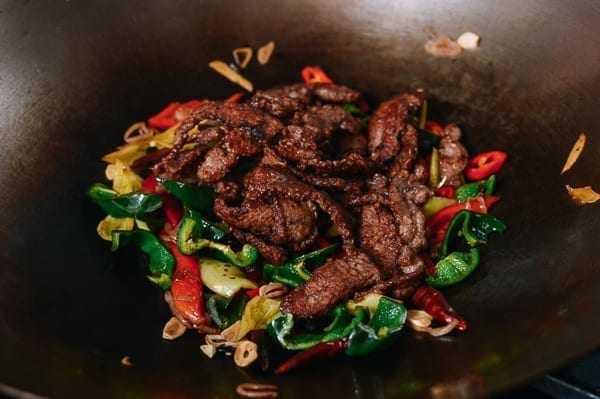
And pour over the pre-prepared sauce.
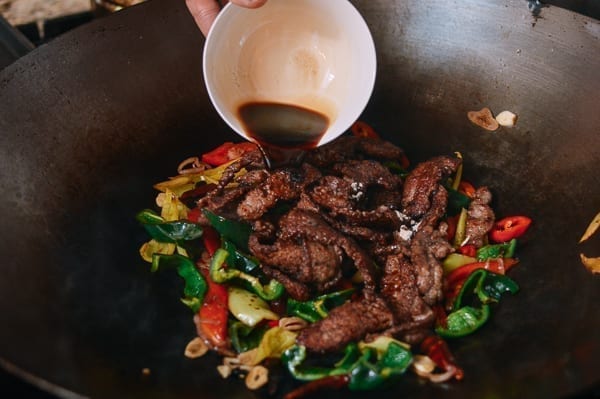
Maintain the highest heat possible and stir-fry everything together for 20 seconds. Add together the scallions.
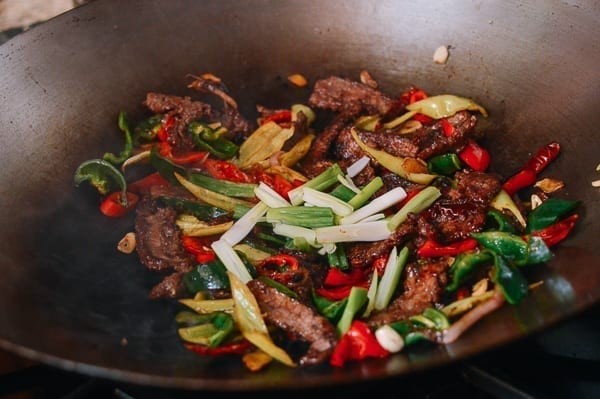
Go along to stir fry until most––if non all––of the sauce has evaporated. Call back that about authentic Hunan stir-fried dishes are relatively dry, without any pools of sauce.
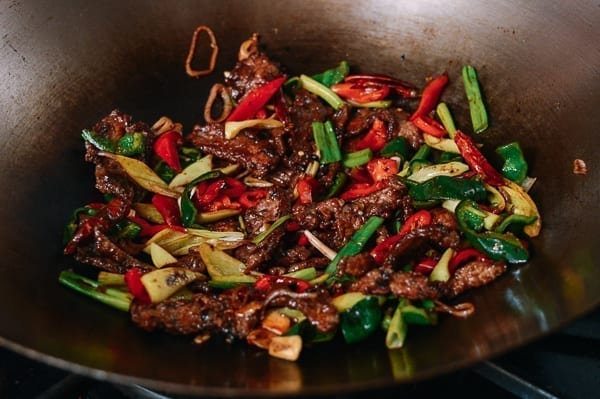
Serve your spicy Hunan Beef with steamed rice and relish!
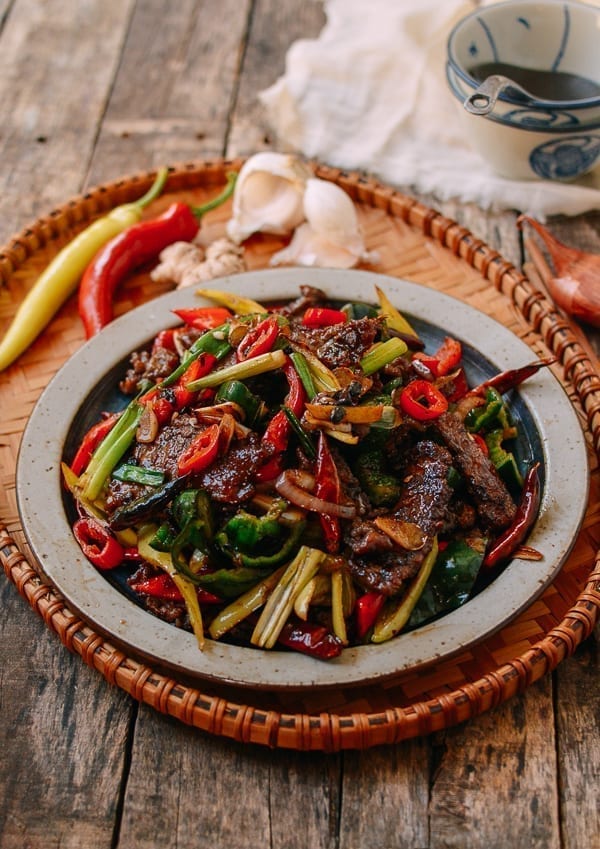
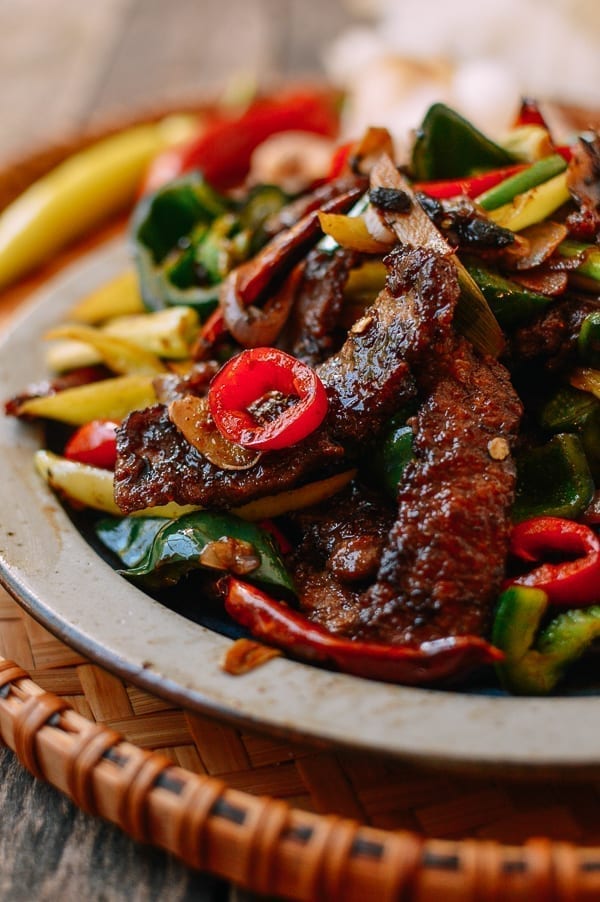
Prep: forty minutes
Cook: 20 minutes
Total: 1 hr
For the beefiness:
- 1 pound flank steak (sliced 1/four-inch thick)
- 1/4 teaspoon baking soda
- two tablespoons water
- 1 teaspoon oyster sauce
- ane/3 cup cornstarch
Preparation:
-
In a medium bowl, combine the sliced flank steak with the baking soda, h2o and oyster sauce. Massage these ingredients into the beefiness until any liquid has been captivated by the meat. Marinate for xxx minutes.
-
Lightly dredge all of the beef slices in cornstarch. Gear up aside until ready to fry.
-
Piece all the fresh peppers crosswise into sparse slices on the diagonal. Ready aside the stale red peppers. Do non pause them open or chop unless you want a very spicy Hunan Beef!
-
Stir the carbohydrate into 2 tablespoons of hot water until dissolved. Add the Chinese black vinegar, soy sauce, and ground white pepper. Mix until well combined and set aside.
-
Oestrus your wok over loftier oestrus until smoking. Spread ⅓ cup oil around the wok, and sear the beef in three batches on both sides until browned and slightly crispy on the outside. Be sure the wok and oil are hot each time you add a batch of beef.
-
Drain the crispy beef past moving it up to the side of the wok. The oil will drain to the lesser and yous can then transfer the beefiness to a sheet pan or plate. No need for paper towels or wire racks!
-
Afterward frying the beef, leave about ii tablespoons of the oil in the wok, and remove any excess. If your wok got burned in the frying process, this is a proficient time to wash information technology. While you want the beefiness flavor from frying, you lot definitely don't want burned bits in the stir-fry if y'all got carried abroad with the heat during frying.
Assembling the stir-fry:
-
Prepare the wok over medium rut. Add together the sliced ginger and fry until caramelized, about 30 seconds.
-
Next, add the shallots. Continue to fry for another 30 seconds, and add the fresh peppers (except for the red holland or fresno peppers). Turn the heat upward to high and stir-fry for one minute to get a nice sear on the peppers.
-
Clear a section on the lesser of the wok, and add the stale chili peppers. Let them toast in the oil for 20 seconds. (If you want your dish spicier, add the dried chili peppers earlier, along with the shallots.)
-
Side by side, pour the Shaoxing wine around the perimeter of the wok. Add the sliced garlic, fermented blackness beans, and the cherry-red Holland or Fresno peppers. Stir-fry for another 30 to sixty seconds on loftier estrus.
-
Side by side, add the fried beef and pour over the pre-prepared sauce. Maintain the highest heat possible and stir-fry everything together for 20 seconds. Add the scallions. Go on to stir fry until most––if non all––of the sauce has evaporated.
Calories: 360 kcal (18%) Carbohydrates: xx g (seven%) Protein: 28 g (56%) Fat: xviii g (28%) Saturated Fat: 11 1000 (55%) Cholesterol: 68 mg (23%) Sodium: 812 mg (34%) Potassium: 619 mg (18%) Fiber: 3 g (12%) Sugar: 4 1000 (4%) Vitamin A: 1490 IU (thirty%) Vitamin C: 85 mg (103%) Calcium: 38 mg (4%) Iron: 3 mg (17%)
Source: https://thewoksoflife.com/hunan-beef/
0 Response to "What Is Typically in Beef With Garlic Sauce at a Chinese Resturant"
Publicar un comentario